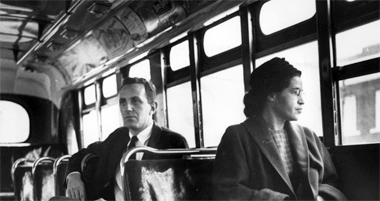25 October 2005
Rosa Parks

Lots of blogging and news today about the passing of Rosa Parks today at age 92. Google’s blog search shows well over 15,000 blog posts, so I’m not sure I have much to add. Still, I want to point to both her own words and the organizational context which seems absent from most versions of the story.
This morning Democracy Now today aired an interview with her from 1956, a year after the incident, and shortly before the end of the bus boycott. From it I learned a couple of things:
She was not actually at the front of the bus, but at the front of the ‘Negro section’ of the bus. The routine was that when the ‘white’ part was full, black passengers were expected to give up their seats and stand so that whites could sit.
She was not some young radical, but a full 43 when she refused to stand. Rev. King, on the other hand, was all of 26 that winter.
It was not just her civil disobedience and arrest, but the story of it that catalyzed the larger action. She was not the first to refuse her seat nor to be arrested for it, but the timing was right. Her arrest came just months after the lynching of Emmett Till. At the time, the Women’s Political Council was building a case to challenge Jim Crow laws. The organization had been working for ten years to fight the mistreatment of black bus riders.
Mrs. Parks had been involved with the organization and with the broader civil rights movement, in NAACP and with her church. She was helping prepare for a major NAACP youth conference at the time of her arrest. I suspect her involvement with these networks helped spread the word. The Women’s Council distributed 35,000 flyers urging blacks to boycott the buses on December 5, the day of Mrs. Parks’s trial.
In her own words:
“The driver said that if I refused to leave the seat, he would have to call the police. And I told him, ‘Just call the police.’ He then called the officers of the law. They came and placed me under arrest, violation of the segregation law of the City and State of Alabama Transportation. I didn’t think I was violating any. I felt that I was not being treated right, and that I had a right to retain the seat that I had taken as a passenger on the bus. The time had just come when I had been pushed as far as I could stand to be pushed, I suppose. They placed me under arrest. And I wasn't afraid. I don't know why I wasn’t, but I didn’t feel afraid. I had decided that I would have to know once and for all what rights I had as a human being and a citizen, even in Montgomery, Alabama....
And Monday morning, when the buses were out on the regular run, they remained empty. People were walking or getting rides in cars with people who would pick them up, as best they could. On Monday night, the mass meeting at the Hope Street Baptist Church had been called. And there were many thousand people there. They kept coming, and some people never did get in the church, there was so many.
I was not the only person who had been mistreated and humiliated. I have been refused entrance on the buses because I would not pay my fare at the front and go around to the rear door to enter. That was the custom if the bus was crowded up to the point where the white passengers would start occupying. I hadn’t thought that I would be the person to do this. It hadn’t occurred to me. Others had gone through the same experience, some even worse experience than mine, and they all felt that the time had come, that they should decide that we would have to stop supporting the bus company until we were given better service. And the first day of remaining off the bus had been so successful. It was organized, in that we wouldn’t ride the bus until our request had been granted.”
During the boycott Mrs. Parks was unable to find work in Montgomery — no one would hire her. She moved to Hampton, Virginia and ultimately to Detroit with her husband.
The photo above was taken while she sat on a bus in front of the Supreme Court in November 1956, awaiting the decision that would find segregation on transportation unconstitutional.
Rest in peace, Mrs. Parks.

